British and American aircraft rockets of World War II
After the outbreak of hostilities in North Africa, British aviators realized that 20-mm air cannons were not effective enough against German armored vehicles, and aerial bombs have low accuracy and require the use of special fuses or braking devices when bombing from low altitudes. At the same time, information was obtained about the large-scale use of rocket projectiles by the Soviet air forces during combat operations against the Nazis.
At that time, installations with 76-mm unguided anti-aircraft missiles were already in service in the UK. 76-mm anti-aircraft missile was a simple tubular structure with stabilizers, the engine used a charge of 5 kg of smokeless powder - cordite brand SCRK.
Using the engine from a 76-mm anti-aircraft missile, several variants were soon created. aviation rockets RP-3. These rockets featured a replaceable warhead that was screwed onto a “tube with stabilizers”.
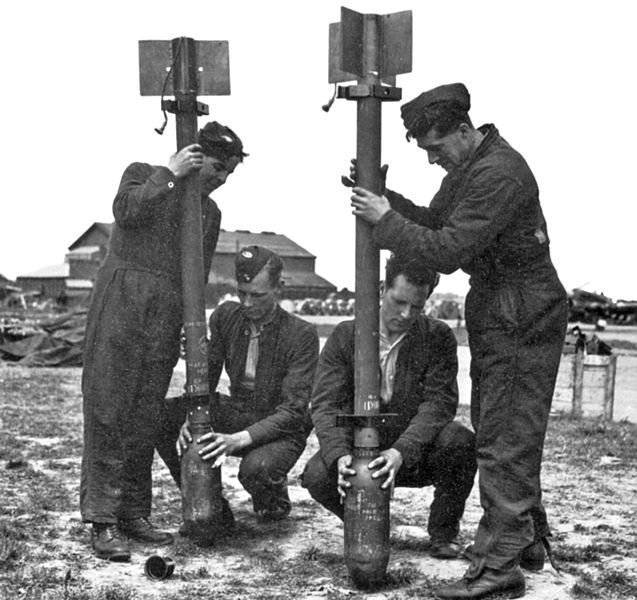
Initially, two interchangeable warheads were developed for various purposes: an 25-pound armor-piercing (11,35 kg) 3.44 inch (87.3 mm) caliber and a high-explosive fragmentation 60-pound (real mass, which, despite the designation, was 47 pounds or 21,31 kg) 4.5 (real weight, inches (114.3 - mm).
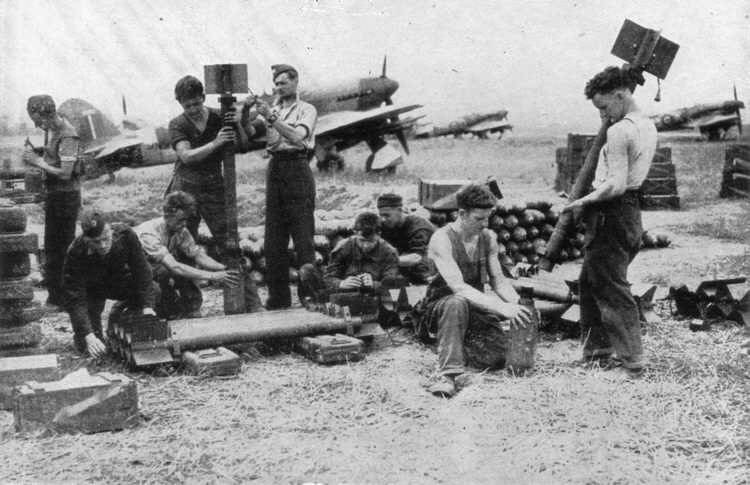
The installation of a particular combat unit took place immediately before the combat flight and took no more than a few minutes for ground personnel. In addition to the "standard" warheads, which were officially in service, various improvised combat units were manufactured in military arsenals. Thus, during the fighting in Italy, local airfield craftsmen managed to combine the “pipe” of the engine with stabilizers with an 114.3-mm artillery shell equipped with white phosphorus, thus obtaining an incendiary rocket.
25-pound armor-piercing rocket projectile was essentially a steel bar, not containing explosives. The total curb weight of the 25-pound missile was 21 kg. Powder charge accelerated the rocket to 430 m / s. The effective range of shooting was about 1000 meters. The tests showed that at a distance of 700 m 25-pound missile pierced 88-mm armor. The striking effect was intensified by the fact that the cord that continued to burn on the main engine had a strong incendiary effect.
Up to 1943, the 25-pound armor-piercing missile, designated as "25-lb AP rocket Mk.I", was able to hit any German tank. However, low accuracy, even with salvo shooting by several missiles, did not provide an acceptable probability of hitting the target, which reduced the combat value of this weapons.
25-pound rockets began to be actively used by British assault aircraft in North Africa from June 1942, but by the end of the war, due to their low effectiveness, they were almost no longer used against ground targets.
However, in the marine antisubmarine aircraft, these shells were successfully used throughout the war. A special modification of the 25-lb AP rocket Mk.II was developed specifically to defeat the hull of shallowly submerged enemy submarines. With their help, it was possible to confidently hit enemy submarines at a depth of 10 m. Although hitting a single rocket into the hull of the boat, as a rule, did not lead to its destruction, but after being damaged, the submarine was unable to dive and was doomed.
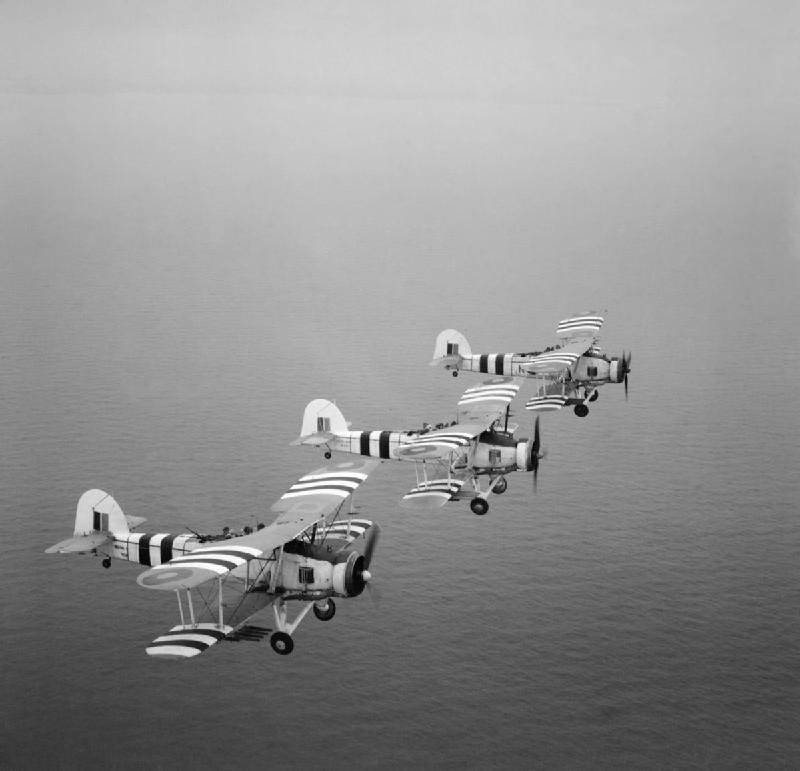
23 May 1943 in the North Atlantic, the first German U-752 submarine was sunk by a volley of armor-piercing missiles from the Soordfish biplane. After only five days in the Mediterranean, a rocket salvo from the Hudson patrol sent another submarine to the bottom.
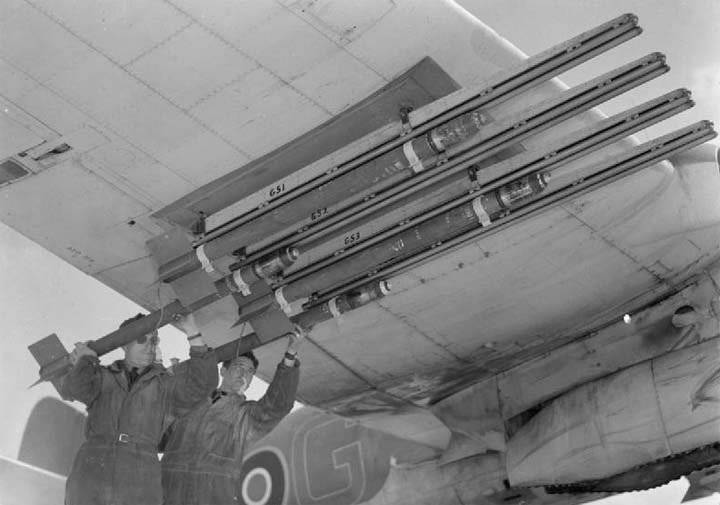
By the end of World War II, Allied aircraft destroyed about 250 German submarines, which accounted for a quarter of their total number of losses. Pilots preferred precisely missiles to attack submarines in shallow water or on the surface.
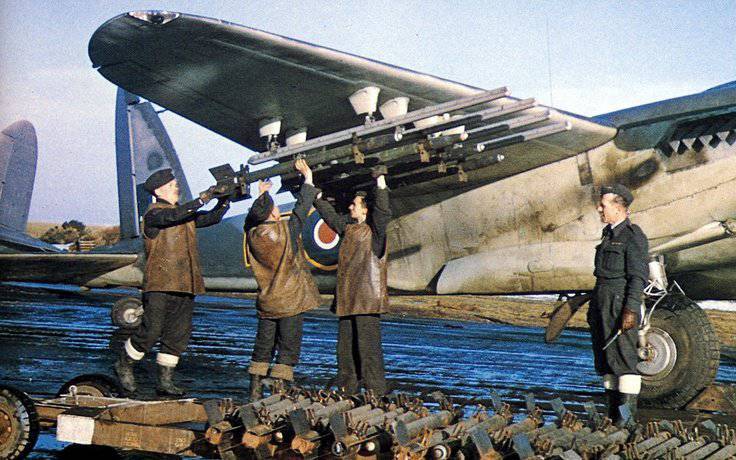
Much more active against ground targets used 60-pound missiles, which were originally developed specifically for the fight against German submarines. But in this role, they are not very successful.
The 60-pound missile of the “60lb NOT No1 Mk.I” modification contained an 3 pound of explosive (1.36 kg), equipped with either pure TNT or a mixture of RDX and TNT. This was not enough to cause serious damage to the submarine during a close gap. At the same time, high-explosive shells could not "dive" as deep as armor-piercing.
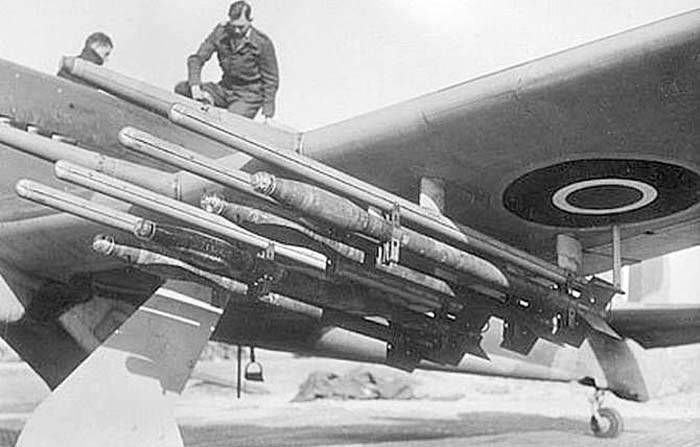
In this regard, it was decided to abandon the use of these weapons for attacks of naval targets, limiting themselves to land use. Missiles were successfully used in attacks of area targets, such as transport convoys, railway trains, airfields, depots and troop concentrations.
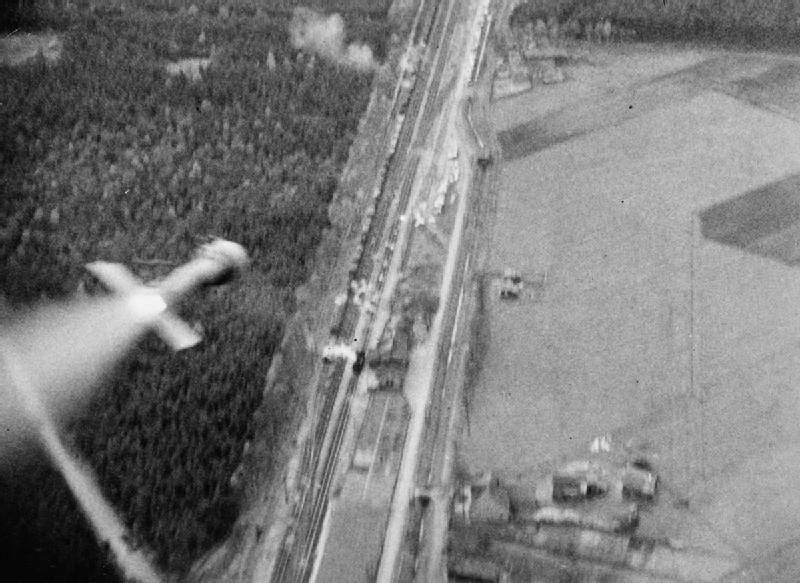
At the end of 1943, an improved version of the 60lb SAP No2 Mk.I rocket was developed, the most widely used in British aviation.
The caliber of the warhead increased to 152 mm, and the explosive mass in the warhead increased 4 times (5.45 kg). The warhead weighing 27.3 kg had an armor-piercing tip of hardened steel and was able to penetrate armor up to 200 mm in thickness at a distance of 1 km. Due to the fact that the missile main engine remained the same, and the mass of the warhead increased significantly, the flight speed dropped to 350 m / s, which caused a deterioration in accuracy and a decrease in effective firing range.
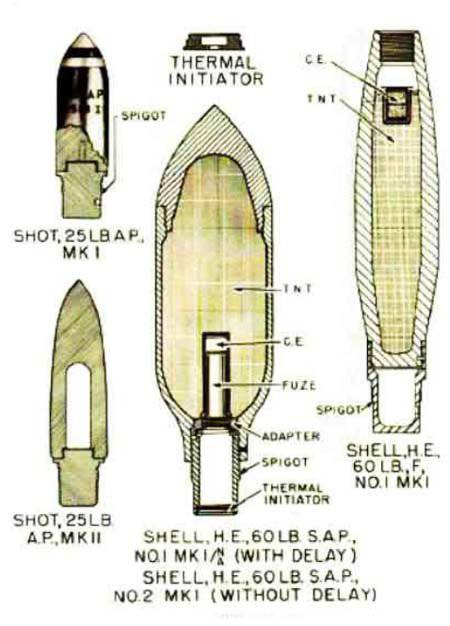
Warheads of english rockets. Left: 25-pound armor-piercing, at the top "25lb AP rocket Mk.I", at the bottom - "25lb AP rocket Mk.II". Right: high-explosive 60-pound "60lb NOT No1 Mk.I". In the middle: an 60-pound 60lb No2 Mk.I armor-piercing, to the designation of which was often added “SAP” - semi-armor Piercing, semi-armor
Hit 60-pound rocket "60lb SAP No2 Mk.I" in the heavy frontal armor tank if it did not lead to its destruction, it inflicted severe damage and incapacitated the crew. When the warhead containing 60 pounds of powerful explosive was nearly torn, the undercarriage, gun, and surveillance devices were damaged.
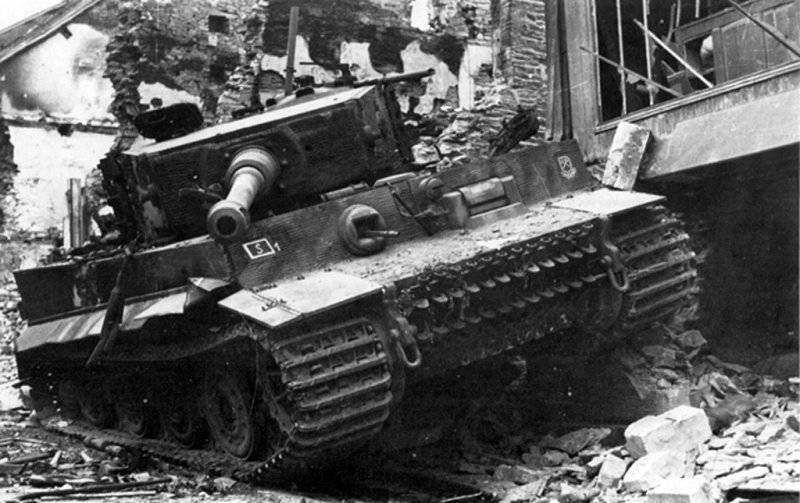
It is assumed that the cause of the death of the most productive tank ace of the 3-th Reich Michael Wittman together with his crew was getting into the aft part of his "Tiger" 60-pound rocket from the Typhoon.
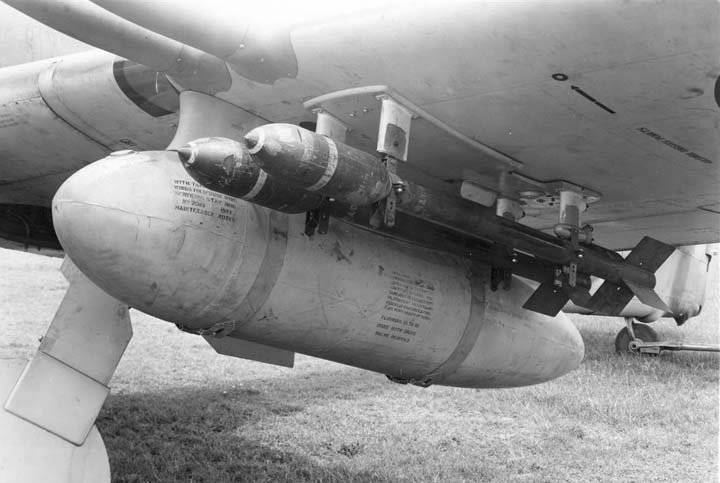
In fairness it should be said that a direct hit on the tank by a rocket was a rather rare event. Although the British missiles due to a more powerful engine and as a consequence of higher flight speeds were more accurate than the Soviet ones, for one destroyed German tank there were about 200 missiles and 25 sorties. In combat, the probability of a missile being hit by a single tank did not exceed 0,5%. Thus, British aircraft missiles cannot be considered effective anti-tank weapons. Therefore, to treat the statements of British pilots about the hundreds of destroyed "Tigers" must be critical.
Due to the fact that the bulk of the 60lb SAP No2 Mk.I rocket fell on the front part, it almost immediately dropped out after launch, which was required to be taken into account when firing.
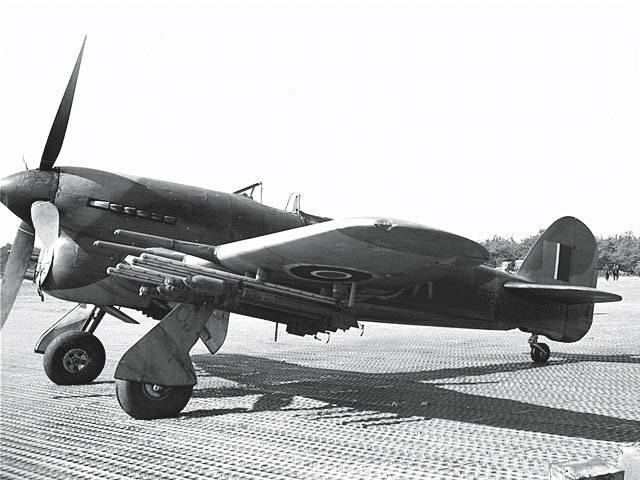
The standard tactic of the British attack aircraft "Tempest" and "Typhoon" involved diving at a target at an angle of up to 45 degrees. Less experienced pilots at that moment opened fire on the target with tracer shells in order to visually establish the line of fire. After that, it was necessary to slightly lift the nose of the aircraft in order to allow for the rocket to go down. Accuracy of shooting was more dependent on the pilot's intuition and his experience in using such weapons.
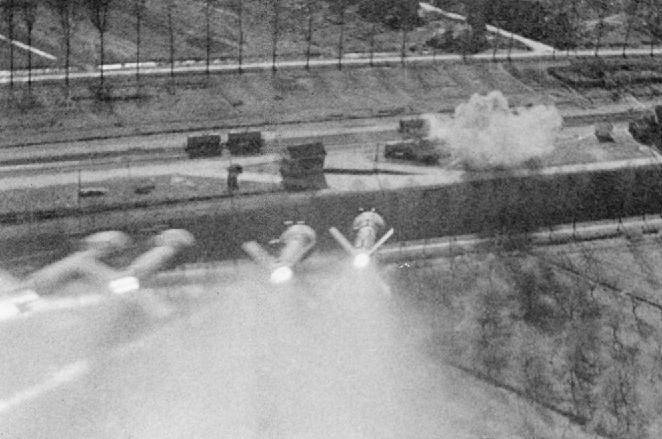
The range of fire usually ranged from 500 to 1000 meters. At a longer range, the accuracy was unsatisfactory; with a smaller launch range, there was a danger of not taking the plane out of a dive or "running into" the breaks of its own missiles.
At the end of the war, rockets with a cumulative warhead appeared, but the British didn’t have time to use them en masse in the warfare of the World War 2.
In the American military aircraft during the Second World War missiles were used even in large volumes compared with the British. The most famous American missiles series M8 produced millions of copies.
The American M8 rocket was originally developed for weapons of combat aircraft and did not have any other prototypes, like the British RP-3. The Americans began to develop their own missiles later than the British, however, the result was not much better.
After successful tests in 1942, the missile, which received the standard military designation M8, was launched in 1943, mass production. The total production volume amounted to over 2,5 million pieces in various versions.
The 4,5 caliber caliber of inches (114 mm) and 911 mm length weighed 17,6 kg. An armor-piercing, explosive-free pig or a high-explosive projectile containing 1,9 kg of TNT was used as a warhead. 30 powder bombs with a length of 127 mm and a total mass of 2,16 kg, which propelled the projectile to a maximum speed of 260 m / s, were used as jet fuel.
Due to the fact that the rocket had a narrowing in the tail section, into which five collapsible spring-loaded stabilizers fit, which opened at the exit of the rocket, the launch was carried out from tubular guides with minimal aerodynamic resistance compared to other types of launchers. Three modifications of the guide for the M8 rockets were produced, the most common were the plastic M10, except for them were the steel M14 and from the magnesium alloy M15. The guides had the same length (about 3 m) and differed in weight (plastic weighed - 36 kg, steel - 86 kg, magnesium - 39 kg). The lightest plastic guides had the lowest resource. Launchers were mounted in a block of three pieces under each wing of American fighters. This bundle had the designation T30.
Originally the carrier of the M8 was the Curtiss R-40 "Tomahawk" fighter, but then almost all types of front and deck aircraft were armed with this rocket.
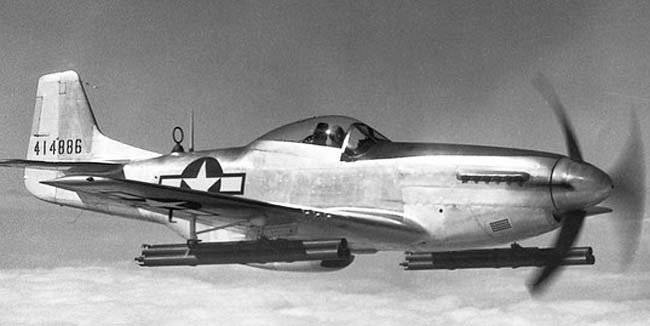
Taking into account the experience of combat use in Burma at the end of 1943, an improved model М8А2, and then А3 went to the series. The new version of the rocket folding area stabilizers has been increased.
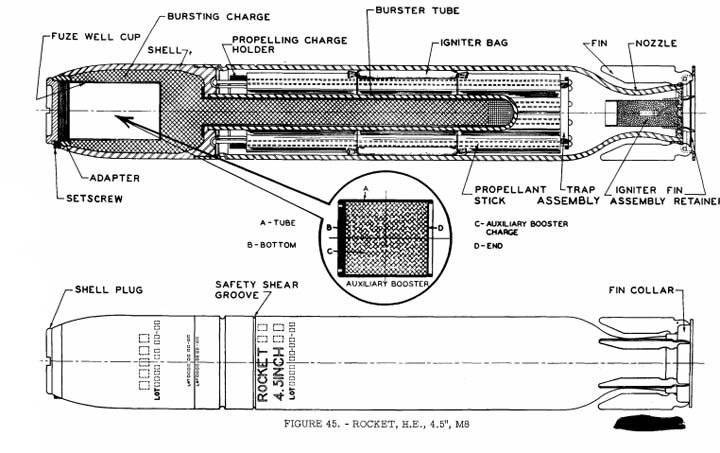
In addition, due to the introduction of a new formulation of gunpowder, the thrust of the cruise rocket engine was increased. The combat part of the projectile also became larger, equaling in diameter with the march. This led to improved accuracy and performance. In the process of launching the M8 missiles, their modifications multiplied. Over the course of 1944-1945, the semi-armor T78 and high-explosive T83 appeared.
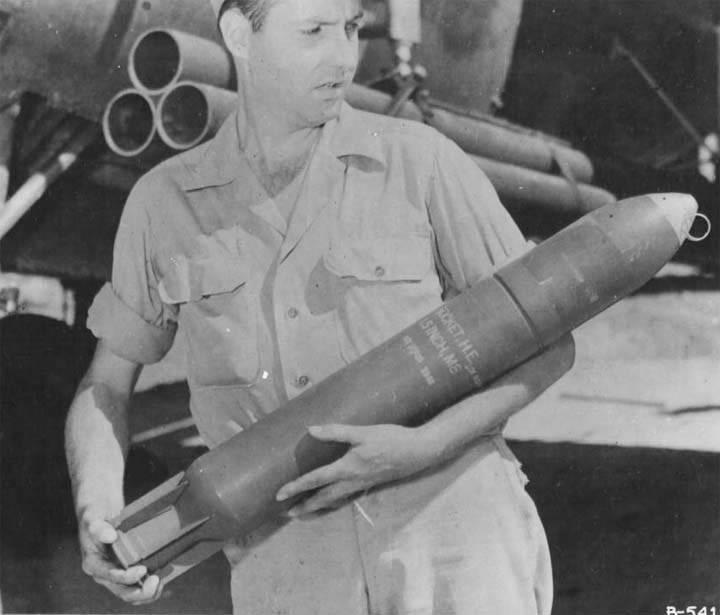
The M8 family of missiles was used very intensively during the fighting. The scale of the application is indicated by the fact that the American 12-I Air Army, which was armed with the Thunderbolt Р-47 fighters, used up to МNNXX 1000 missiles during the fighting in Italy. The M8 missiles were widely used in the Far East in battles with the Japanese.
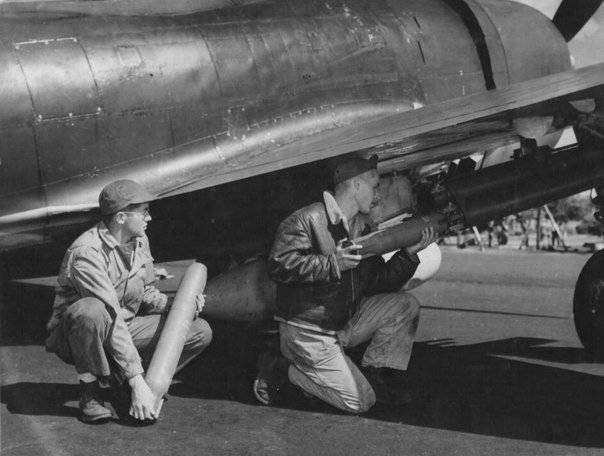
At the end of 1944, a more powerful version of the M8-based projectile, conventionally designated as "Super M8", was developed. Significantly increased: the speed, accuracy and power of the missile warhead. However, due to the end of the war, this rocket was fired only in a small party.
In the 1943, the US Navy received an 3,5-inch (89-mm) anti-submarine missile "3,5 FFAR" (Forward Firing Aircraft Rocket literally - firing forward missile). Even at the development stage, this rocket did not have high requirements for flight range. The military wanted to have a cheap and simple missile in service with naval aviation, capable of striking submarines under snorkel. A total of about 10000 shells were produced.
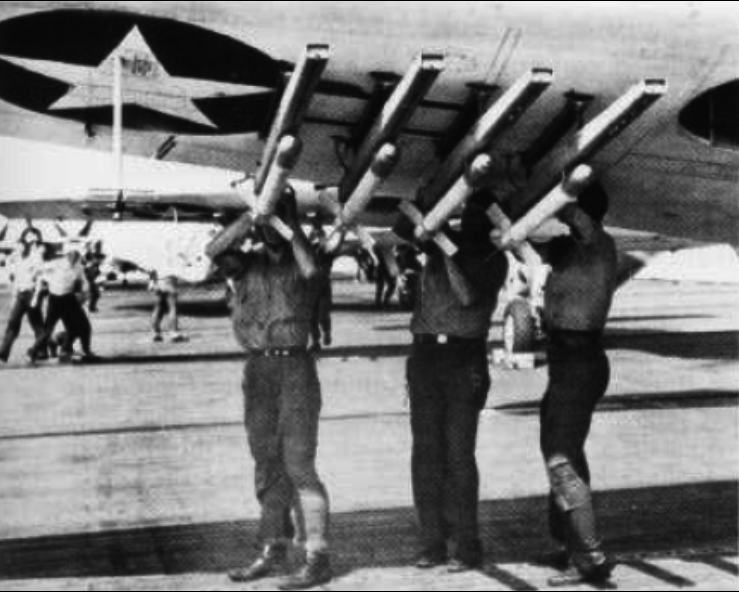
This weapon appeared under the influence of the British development of rockets to combat submarines. The mass of the missile was 24.5 kg of which 9 kg accounted for all-metal armor-piercing warhead. The powder engine provided her with a speed of 360 m / s. The effective firing range was about 1400 meters. The rocket confidently kept the trajectory under water, reaching an underwater target at a depth of up to 30 meters.
The 3,5 FFAR was used exclusively by US naval aviation, due to the fact that the rocket was not effective enough, it was soon replaced by a more powerful 5-inch 5 FFAR. The new rocket used the same sustainer rocket engine with a diameter of 89 mm, which was mounted 127-mm warhead from anti-aircraft artillery shells. From the middle of the 1944 of the year, the 5-inch version completely supplanted the earlier 3,5-inch.
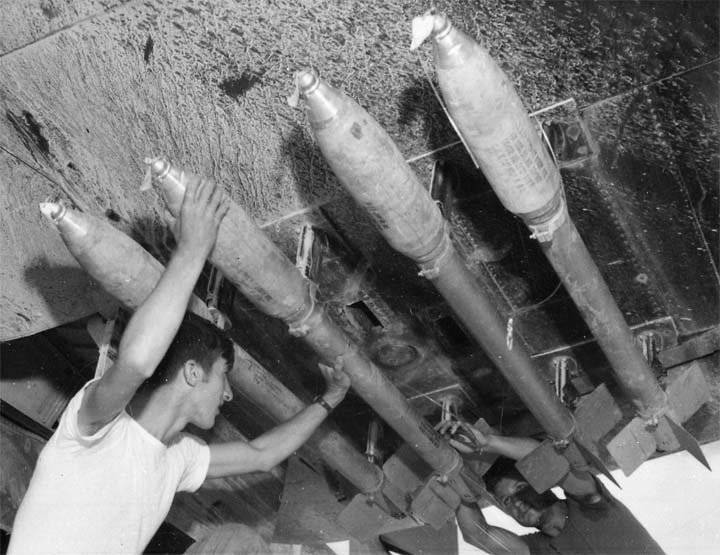
Due to the significant increase in weight of the warhead, the speed of the 36-kg of the rocket dropped to 217 m / s. The reduction in speed was compensated for by a powerful high-explosive warhead weighing 20 kg, containing 2,9 kg of explosives.
Missiles "5 FFAR" actively used by American naval aviation, mainly in the Pacific.
At the same time, the military expressed a desire to have an aviation missile armed with a powerful warhead like the 5-inch "5 FFAR" and the speed of the 3,5-inch "3,5 FFAR", as well as to increase the accuracy of shooting.
In July, the 1944 of the 127 HVAR (High Velocity Aircraft Rocket, a high-speed aircraft rocket), also known as Holy Moses, began to flow into the air units.
When developing a rocket, two types of warheads with a mass of 20,4 kg were initially assumed: an all-metal armor-piercing and a high-explosive armor, containing 3,5 kg of explosives. The rocket length was 1,83 m, weight 64 kg. A more powerful sustainer solid fuel engine reported her speed 420 m / s. Effective range up to 2000 m.
The 127-mm rocket "5 HVAR" combined the high speed and penetration capability of the armor-piercing "3.5 FFAR" and the destructive action of the high-explosive "5 FFAR". Shooting accuracy was also significantly increased. These missiles were used very widely and effectively against both marine and ground targets.
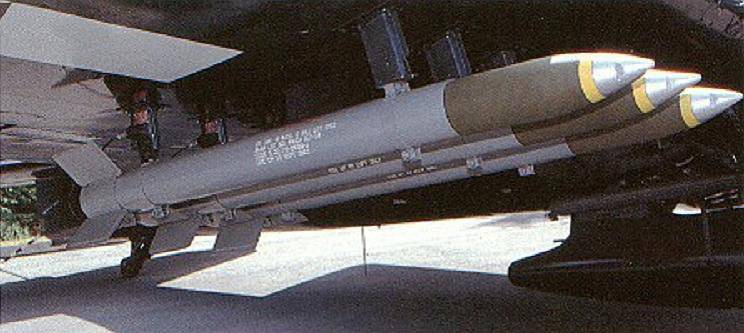
There were dozens of options for serial and experimental suspension of HVAR missiles on a variety of army aircraft and fleet USA.
127-mm missiles "5 HVAR" for a complex of operational and combat characteristics have become the most advanced aircraft missiles of the Second World War. After the war, they remained in service for a long time and were used in many armed conflicts around the world.
Shortly before the end of hostilities, the most powerful 11,75-inch (298,5 mm) Tiny Tim rocket aircraft entered US aircraft.
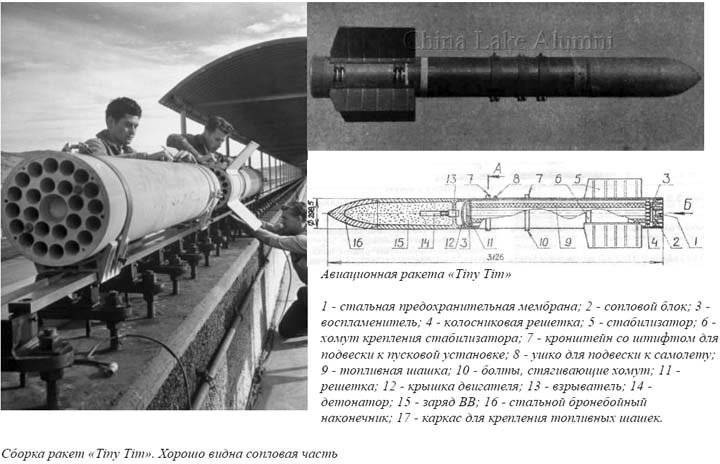
The 11,75 Tiny Tim missiles were supposed to be used against the positions of German V-2 missiles, bridges and long-term fortifications. A warhead weighing 267 kg, containing 66 kg of explosives, could penetrate reinforced concrete floors with a thickness of 1 meter. The missile had a starting weight of 581,7 kg, length 3,129 m, diameter - 298.5 mm, span of stabilizers 910 mm.
Because of the heavy weight, it was intended to arm first of all the bombers, but its installation on fighters was also not excluded. For the rocket the launcher was not developed - it was suspended from the standard bomb racks of the corresponding payload.
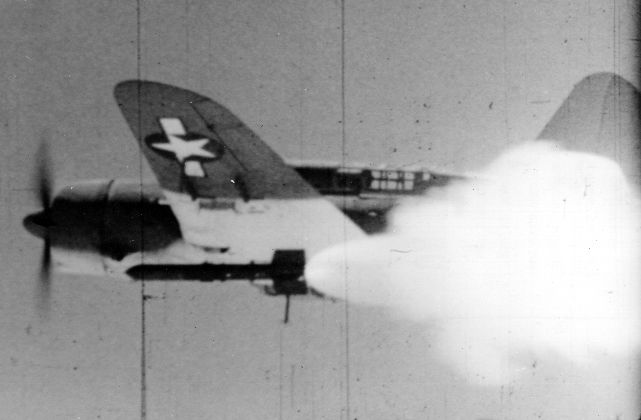
After the reset, the exhaust cord was unwound, attached to the aircraft, which at a safe distance from the carrier launched the rocket engine.
The Tiny Tim missile was late for the war, only a small number of missiles were used in the final battles for the island of Okinawa against Japanese fortifications.
Assessing the effectiveness of Allied aviation rockets, it is worth noting that the real use of missiles as anti-tank weapons was initially overestimated. For example, a statistical analysis of the effectiveness of the British 2 tactical air army and the American 9 air army in the battles of Morten in August 1944 showed that only 43 of 7 destroyed German tanks were hit by a missile air strike. The attacks against less protected targets, such as armored cars and armored personnel carriers, were more effective.
Similar results were shown by the research of the Allied operation “Falesa Sack”, which took place in the same month. As a result of the fighting, rockets destroyed only 1,7% of German tanks.
At the same time, high-explosive rocket projectiles proved to be quite effective in shelling enemy positions and transport columns. Rocket attacks had the strongest demoralizing effect on German soldiers. A survey of German prisoners of war later confirmed the tremendous psychological effect of air attacks, especially missile attacks, to which even veteran crews were exposed.
Based on:
http://www.wwiiequipment.com/
http://www.designation-systems.net/
http://www.airwar.ru/weapon/anur/m8.html
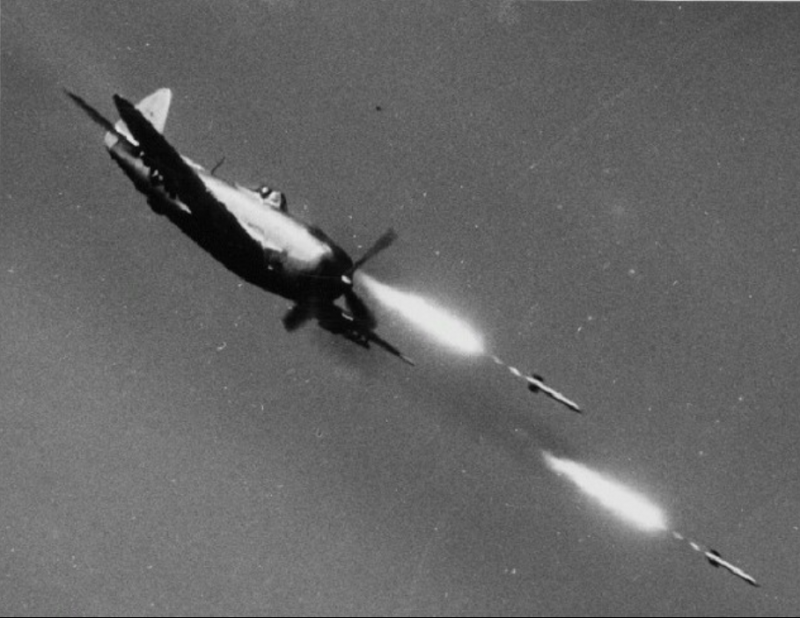


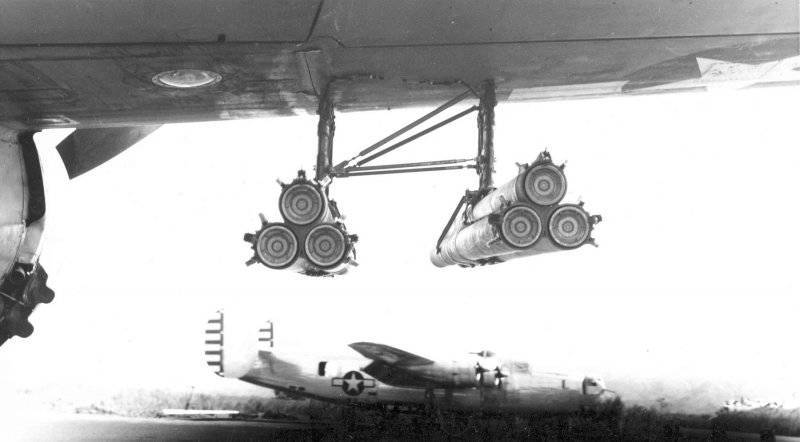
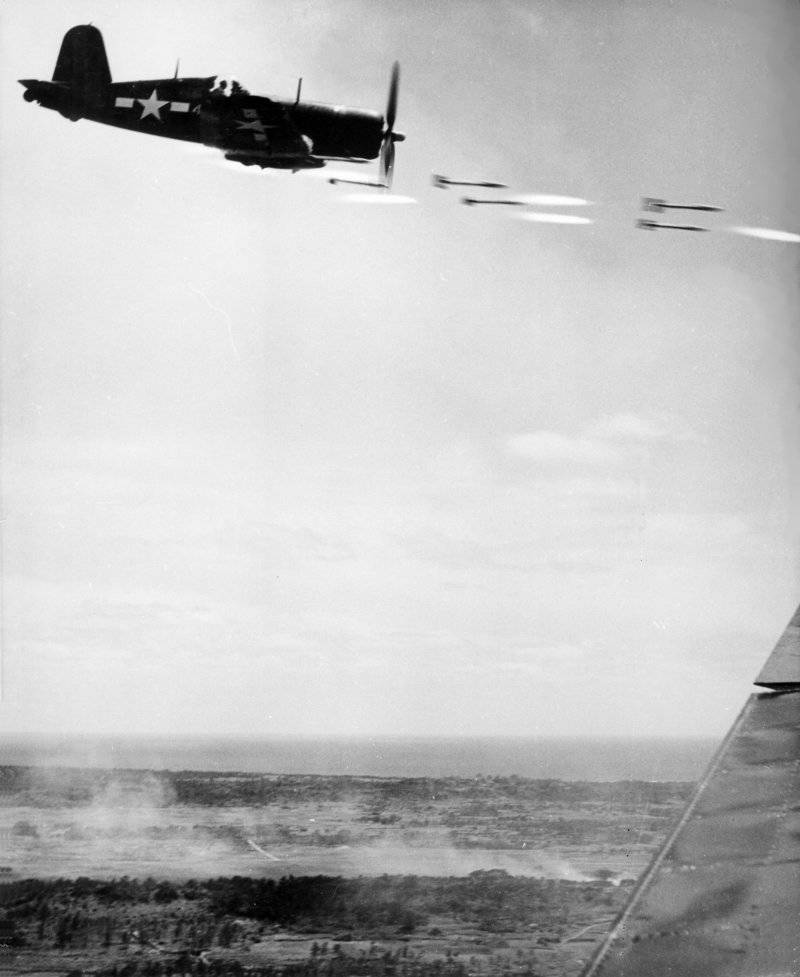
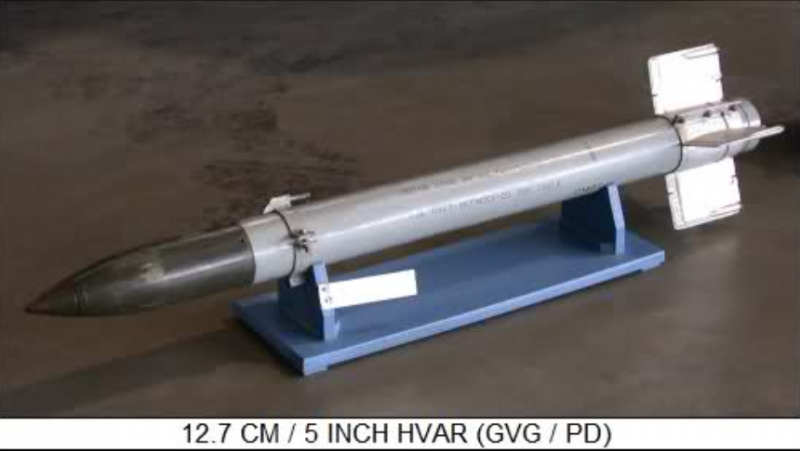
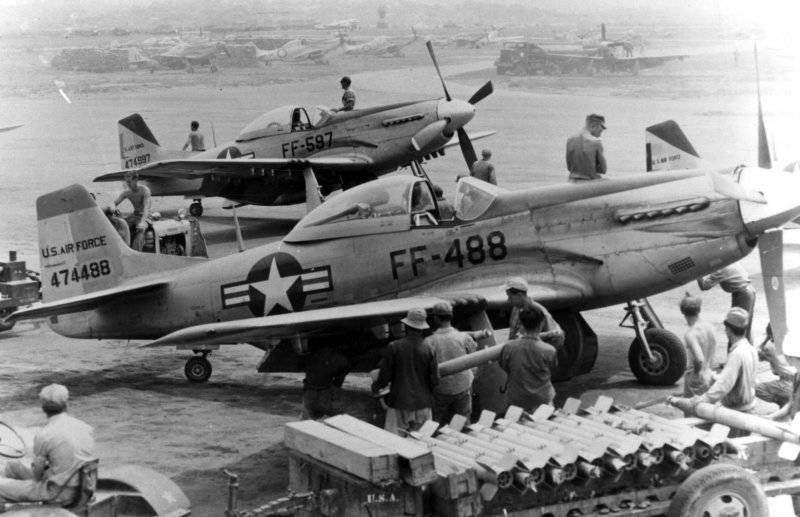
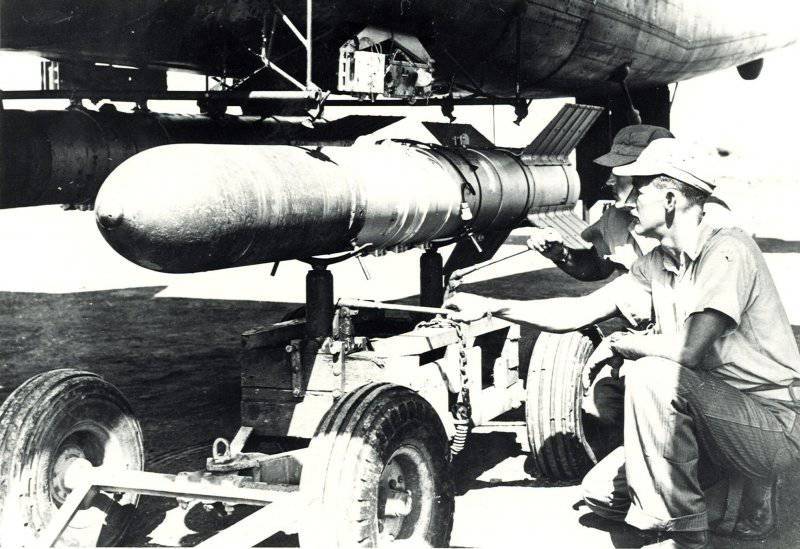
Information